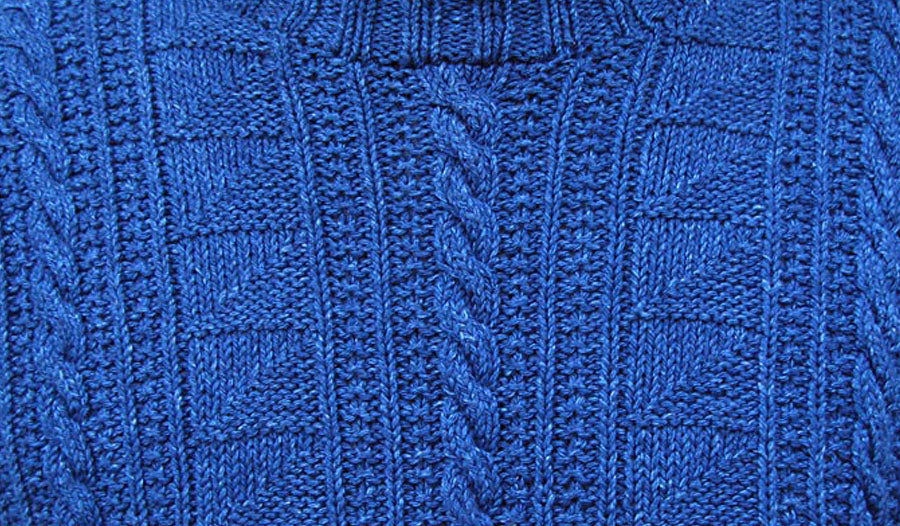
Image: Gansey in Whitby pattern. Credit Stitched & Stitched
It is cold, wet and dangerous out there - this is where the Gansey was born and thrived. Keeping men warm in the worst of weathers, fiercest of winds and wildest of seas. No wonder they are revered by so many designers, knitters, historians and wearers...
Aran, Fair Isle, Llopapeysa, Lusekofta; in the latest issue of Selvedge, Issue 104 Keeping Warm, we asked five of our favourite knitting experts to advocate for their preferred style of hand-knit sweater. Read on for Di Gilpin's appraisal of Gansey.
I grew up by the North Sea with the salt in my blood and knitting needles for hands from an early age and thus the Gansey has been a passion for ever. The Gansey in all its complexity and beauty represents the harmony between utility and aesthetics. Created out of necessity, the density of the handknitted fabric–with an incredible tension of up to 60 sts to 10 cms–keeps the wearer warm in the face of the coldest of days. The wool, worsted spun and plyed by five, wears forever and develops an almost shiny surface with time and wear. Often created in dark indigo blue for practicality, the intense patterning rises out of the surface in defiance of the depth of tension in the fabric. These patterns, motifs, and symbols have an age to them. Simply put, they have been created over generations and refined and reworked, always showing the Hand of the Knitter.
 Image: Gansey swatches. Courtesy Di Gilpin
Image: Gansey swatches. Courtesy Di Gilpin
In writing The Gansey Knitting Sourcebook, my co-author, Sheila Greenwell and I researched the collections held at the Scottish Fisheries Museum. We discovered handwritten notes of the patterns going back generations in the family of Isabella Stewart. Trees, waves, herringbones and uniquely ‘heapies’, which originate from the Buchan dialect of the Doric language describing the stacks of peat seen drying along the coasts of the north and west of Scotland. Some of these Ganseys were a hundred years old, with beautiful darns and repairs. Cuffs were cut off and reknitted in varying shades of blue.
The Hand of the Knitter shows love in every stitch and repair, keeping someone special safe and warm on the worst of days. The designs can be seen as symbolic, as in the Tree of Life or referencing the world of the knitter, ropes and rigging, anchors, harbour steps, herring bones and heapies. Cornish Ganseys, so lyrical in the use of basket weaves and steps, almost create the surface of the sea.

What makes a Gansey special? First, they are knitted seamlessly, traditionally on five long steel double-pointed needles in the round, to make such a dense fabric that it repels water and keeps the wearer warm and cosy. Second, the incredible Gansey stitches and patterns are all made from the simple Knit and Purl stitches, or in the dialect of the Dales in Yorkshire ‘hit and missitt’, and are rich in their complexity, execution and narrative. Third, curious and original devices are used to create a perfect fit, gussets underarm and at the neck, shoulder saddles and straps, short sleeves to keep the wearer safe from nets, hooks and ropes. Fourth, the fit, which is tight and to the body. Finally, they are imbued with that extra special something which comes from being hand-knitted with love.
Fast forward to the present. I gain great comfort in knowing my children are wrapped in such a special garment, which tells its own story and is made with love by hand, using its special protective properties to keep my family warm and safe.
Which handknit sweater style is your favourite? We encourage you to take out your knitting needles!
--
Find out how to read the rest of the Anatomy of a Sweater series here:


